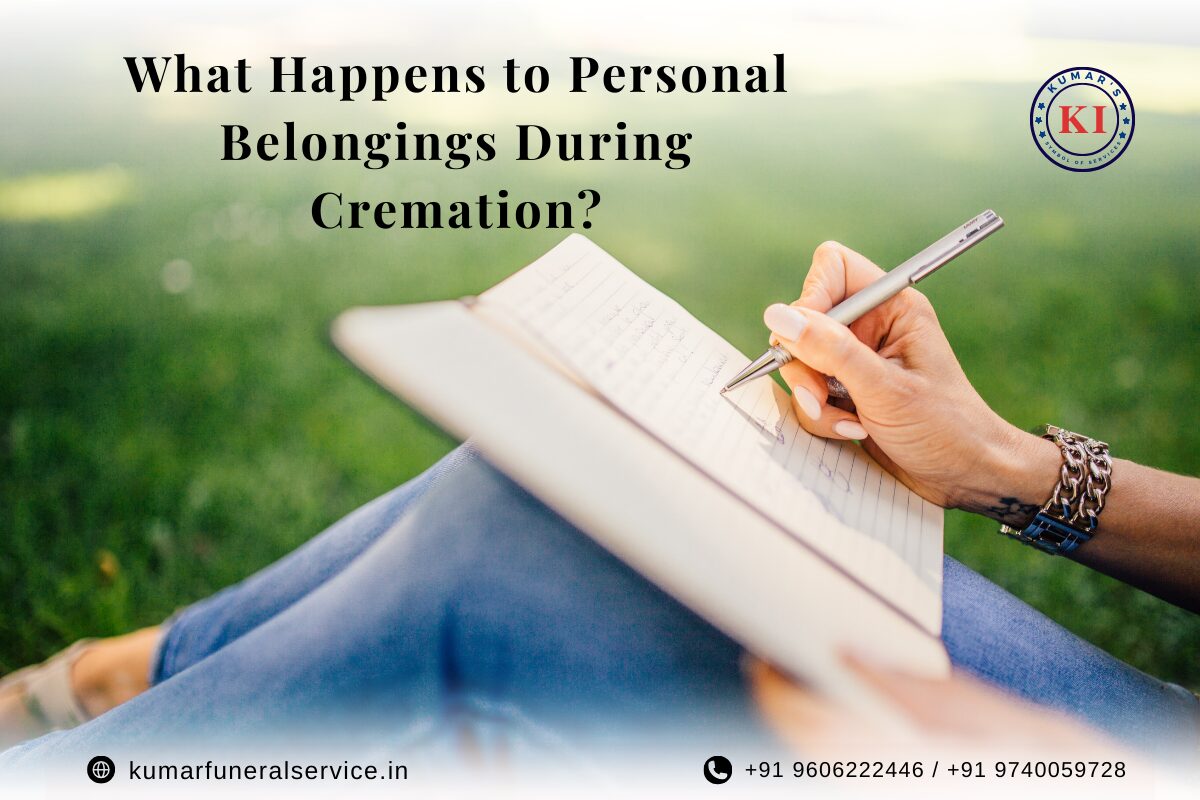Cremation has become a widely accepted practice for handling the personal belongings of loved ones, offering families a dignified and respectful option. During the cremation process, many people wonder what happens to the personal belongings that the deceased may have with them, such as jewelry, clothing, or sentimental items. Understanding how these belongings are handled and the choices available to families can help ease concerns and provide clarity.
At Kumar Funeral Services, Bangalore’s largest funeral service provider, we are committed to offering clear and compassionate guidance through every step of the cremation process, including the handling of personal belongings. This article aims to explain what happens to personal items during cremations and the options available to families who wish to keep or include them.
Personal Belongings and Cremation: A General Overview
Before delving into the specific procedures, it’s important to understand that cremation is an intense process that involves exposing the body to high temperatures, typically between 1,400 to 2,000 degrees Fahrenheit (760 to 1,093 degrees Celsius). These temperatures ensure that the body is reduced to bone fragments and ashes. Because of this, many materials cannot survive the cremation process, while others may interfere with the procedure or pose safety risks.
What Happens to Clothing During Cremation?
The decision about what the deceased will wear during cremations is one that families make, often based on cultural, religious, or personal preferences. In many cases, the deceased is dressed in their own clothing, such as a favorite outfit or something symbolic, while in other cases, they may be cremated in a simple shroud or cloth provided by the crematorium.
At Kumar Funeral Services, we allow families to choose how their loved one will be dressed. If the family opts for clothing, it’s important to note that most materials will be consumed by the intense heat of the cremations. Items made from synthetic fibers, such as polyester or plastic, can sometimes release harmful gases, which is why natural fabrics such as cotton or linen are preferred.
We work closely with families to ensure their wishes regarding clothing are respected, offering guidance on the best materials to use for cremation.
Jewelry and Other Accessories
One of the most common concerns families have is about jewelry and accessories that their loved one may be wearing at the time of cremation. While it may be meaningful for the deceased to be cremated with certain sentimental items, it’s important to understand what happens to these items during the process.
Removing Jewelry Before Cremation
At Kumar Funeral Services, we always ask families if they wish to remove jewelry or any other valuable items before cremation. This ensures that precious family heirlooms or items with significant sentimental value are preserved. If families wish to keep certain pieces of jewelry, we recommend removing them before the cremation takes place.
Once cremation begins, metals, stones, and other materials in jewelry will either melt or be damaged due to the high temperatures. In many cases, the jewelry is either destroyed or becomes unrecognizable after the process. By removing these items beforehand, families can retain these cherished mementos.
What Happens If Jewelry Is Left On?
If jewelry is not removed, it will be exposed to the heat of the cremation chamber. While softer metals, such as gold and silver, may melt, harder materials like stainless steel or platinum may survive in a partial or altered form. Gemstones, depending on their composition, may be destroyed or damaged during cremation. Once the process is complete, any metal or materials left behind are separated from the ashes and typically disposed of by the crematorium.
At Kumar Funeral Services, we offer families the option of returning any remaining pieces after cremation, although this is rare, as most items are either destroyed or become unrecognizable.
Pacemakers and Medical Implants
One of the critical considerations before cremation is the removal of any medical devices or implants that the deceased may have, particularly pacemakers. These devices, which contain batteries, pose a significant safety risk during cremation as they can explode under high heat. Explosions can damage the cremation chamber and pose a risk to staff.
Before cremation, the staff at Kumar Funeral Services conducts a thorough check for medical implants like pacemakers and ensures they are removed. If the deceased has other types of implants, such as metal plates, artificial joints, or dental fillings, these materials will be processed differently. Metal components that survive the cremation process are typically separated from the remains afterward and disposed of in a respectful manner.
Sentimental Items: What Can Be Cremated?
For many families, cremation offers an opportunity to send their loved one off with meaningful or symbolic items, such as letters, photographs, or small personal belongings. These items can be included in the cremation, but it’s important to understand what materials are suitable for the process.
Suitable Items for Cremation
Certain items, such as paper, biodegradable materials, or small wooden objects, can be safely cremated along with the body. Families often choose to include letters, drawings, or small sentimental tokens made from natural materials that won’t interfere with the cremation process. These items will be burned along with the body, and families can feel reassured that their loved ones are accompanied by these meaningful objects.
Items That Should Not Be Cremated
While many personal belongings can be cremated, certain materials are unsuitable due to safety concerns. Items made from metal, plastic, or glass should not be placed in the cremation chamber as they can pose a risk, emit harmful fumes, or damage the cremation equipment.
At Kumar Funeral Services, we guide families on which items can and cannot be cremated, ensuring that the cremation process proceeds smoothly while respecting the wishes of the family.
Post-Cremation Handling of Belongings
After cremation, the remains are processed into ashes, which are returned to the family in an urn or other container. Any materials that survive the cremation, such as metal implants or jewelry, are separated from the ashes. These items can either be returned to the family or respectfully disposed of, depending on the family’s preferences.
The Separation Process
Once cremation is complete, the remaining bone fragments are carefully processed to create a fine powder, commonly referred to as ashes. During this process, any non-organic materials, such as medical implants or metal fragments from personal belongings, are removed using magnets or manual separation techniques.
At Kumar Funeral Services, we ensure that all non-combustible materials are properly handled and that the ashes returned to the family contain only the remains of the deceased.
Respectful Handling of Personal Belongings
Understanding what happens to personal belongings during cremation can bring peace of mind to families during a difficult time. At Kumar Funeral Services, we prioritize respect, transparency, and care in every step of the cremation process. Whether it’s removing valuable items before cremation or ensuring that sentimental objects are safely included, we work closely with families to ensure that their wishes are honored.
By offering guidance on what can be cremated, safely handling medical devices, and returning any remaining items to the family, we strive to provide a meaningful and dignified farewell for loved ones.


